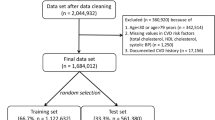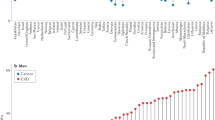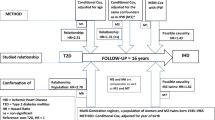Abstract
A 10-year longitudinal population-based study, entitled the Isfahan Cohort Study (ICS) is being conducted. The ICS commenced in 2001, recruiting individuals aged 35+ living in urban and rural areas of three counties in central Iran, to determine the individual and combined impact of various risk factors on the incidence of cardiovascular events. After 24379 person-years of follow-up with a median follow-up of 4.8 years, we documented 219 incident cases of ischemic heart disease (IHD) (125 in men and 94 in women) and 57 incident cases of stroke (28 in men and 29 in women). The absolute risk of IHD was 8.9 (7.8–10.2) per 1000 person-years for all participants, 10.6 (8.8–12.5) per 1000 person-years for men and 7.4 (6.0–9.0) per 1000 person-years for women. The respective risk of ischemic stroke was 2.3 (1.7–3.0), 2.3 (1.6–3.3) and 2.3 (1.5–3.2) per 1000 person-years. The risk of IHD was approximately 3.5-fold higher in the presence of hypertension, followed by diabetes mellitus and hypercholesterolemia with near 2.5- and twofold higher risk, respectively. This cohort provides confirmatory evidence of the ethnic differences in the magnitude of the impact of various risk factors on cardiovascular events. The differences may be due to varying absolute risk levels among populations and the existing ethnic disparities for using western risk equations to local requirements.
This is a preview of subscription content, access via your institution
Access options
Subscribe to this journal
Receive 12 digital issues and online access to articles
$119.00 per year
only $9.92 per issue
Buy this article
- Purchase on Springer Link
- Instant access to full article PDF
Prices may be subject to local taxes which are calculated during checkout



Similar content being viewed by others
References
http://www.who.int/chp/ncd_global_status_report/en/. accessed Oct 15 2009.
Winkleby MA, Robinson TN, Sundquist J, Kraemer HC . Ethnic variation in cardiovascular disease risk factors among children and young adults: findings from the Third National Health and Nutrition Examination Survey, 1988–1994. JAMA 1999; 281 (11): 1006–1013.
Schaefer BM, Caracciolo V, Frishman WH, Charney P . Gender, ethnicity and genetics in cardiovascular disease: part 1: Basic principles. Heart Dis 2003; 5 (2): 129–143.
Yusuf S, Howken S, Ounpuu S, Avezum A, Dans T, Lanas F et al. Effect of potentially modifiable risk factors associated with myocardial infarction in 52 countries (the INTERHEART study): case control study. Lancet 2004; 364: 937–952.
Wild S, Roglic G, Green A, Sicree R, King H . Global prevalence of diabetes: estimates for the year 2000 and projections for 2030. Diabetes Care 2004; 27: 1047–1053.
Naghavi M, Abolhassani F, Pourmalek F, Lakeh M, Jafari N, Vaseghi S et al. The burden of disease and injury in Iran 2003. Popul Health Met 2009; 7: 9.
Sarraf-Zadegan N, Sayed-Tabatabaei FA, Bashardoost N, Maleki A, Totonchi M, Habibi HR et al. The prevalence of coronary artery disease in an urban population in Isfahan, Iran. Acta Cardiol 1999; 54 (5): 257–263.
Sarraf-Zadegan N, Boshtam M, Rafiei M . Risk factors for coronary artery disease in Isfahan, Iran. Eur J Public Health 1999; 9 (1): 41–44.
Esteghamati A, Abbasi M, Alikhani S, Gouya MM, Delavari A, Shishehbor MH et al. Prevalence, awareness, treatment, and risk factors associated with hypertension in the Iranian population: the national survey of risk factors for non-communicable diseases of Iran. Am J Hypertens 2008; 21 (6): 620–626.
Sarrafzadagan N, Amininik S . Blood pressure pattern in urban and rural areas: Isfahan Hypertension Study. J Human Hyperten 1997; 11 (7): 424–428.
Kelishadi R, Alikhani S, Delavari A, Alaedini F, Safaie A, Hojatzadeh E . and associated lifestyle behaviours in Iran: findings from the First National Non-communicable Disease Risk Factor Surveillance Survey. Public Health Nutr 2008; 11 (3): 246–251.
Sarrafzadegan N, Kelishadi R, Baghaei A, Hussein Sadri G, Malekafzali H, Mohammadifard N et al. Metabolic syndrome: an emerging public health problem in Iranian Women: Isfahan Healthy Heart Program. Int J Cardiol 2008; 131 (1): 90–96.
Harati H, Hadaegh F, Saadat N, Azizi F . Population-based incidence of Type 2 diabetes and its associated risk factors: results from a six-year cohort study in Iran. BMC Public Health 2009; 9: 186.
Sarrafzadegan N, Baghaei A, Sadri G, Kelishadi R et al. Isfahan Healthy Heart Program: Evaluation of comprehensive. Community-based interventions for none-communicable disease prevention. Prevention and control 2006; 2: 73–84.
Sarraf Zadegan N, Sadri G, Malek-Afzali H, Baghaei M, Mohammadi Fard N, Shahrokhi S et al. Isfahan Healthy Heart Program: a comprehensive integrated community-based programme for cardiovascular disease prevention and control. Design, methods and initial experience. Acta Cardiol 2003; 58: 309–320.
National Institutes of Health. The practical guide identification, evaluation and treatment of overweigh and obesity in adults. NIH Publication, 9: 2000.
Chobanian AV, Bakris GL, Black HR, Cushman WC, Green LA, Izzo JL et al. National Heart, Lung, and Blood Institute Joint National Committee on Prevention, Detection, Evaluation, and Treatment of High Blood Pressure; National High Blood Pressure Education Program Coordinating Committee. The Seventh Report of the Joint National Committee on Prevention, Detection, Evaluation and Treatment of High Blood Pressure: the JNC 7 report. JAMA 2003; 289 (231): 235–240.
Mc Namara JR, Schaefer EJ . Automated enzymatic standardized lipid analyses for plasma and lipid lipoprotein fractions. Clin Chem Acta 1987; 166: 1–8.
Warnick GR, Benderson J, Albers JJ . Dextran sulfate-magnesium precipitation procedure for quantitation of high-density lipoprotein cholesterol. Clin Chem 1982; 28: 1379–1382.
Friedewald WT, Levy RI, Fredrickson DS . Estimation of the concentration of low-density lipoprotein cholesterol in plasma without use of the preparative ultracentrifuge. Clin Chem 1972; 18: 499–502.
National Institutes of Health. Third Report of The National Cholesterol Education Program Expert Panel on Detection, Evaluation, and Treatment of High Blood Cholesterol in Adults (Adult Treatment Panel III). National Institutes of Health: Bethesda, MD, 2001, NIH Publication 01-3670.
WHO draft protocol and manual of operations population survey for cariovascular disease risk factors in the Eastern Mediterranean Region. World Health Organization: Alexandria (Egypt), 1995, pp 1–35.
WHO. Obesity: preventing and manageing the global epidemic, WHO/NUT/98 World Health Organization: Geneva, Switzerland, 1998.
International Diabetes Federation. The IDF consensus worldwide definition of the metabolic syndrome www.bibalex.org/Supercourse/metabolic/IDF.
Esteghamati A, Ashraf H, Rashidi A, Meysamie A . Waist circumference cut-off points for the diagnosis of metabolic syndrome in Iranian adults. Diabetes Research and Clinical Practice 2008; 82: 104–107.
An epidemiological approach to describing risk associated with blood pressure levels Final Report of the Working Group on Risk and High Blood Pressure. Hypertens 1985; 7 (4): 641–651.
Luepker RV, Apple FS, Christenson RH, Crow RS, Fortmann SP, Goff D et al. Case definitions for acute coronary heart disease in epidemiology and clinical research studies: A statement from the AHA Council on Epidemiology and Prevention; AHA Statistics Committee; World Heart Federation Council on Epidemiology and Prevention; the European Society of Cardiology Working Group on Epidemiology and Prevention; Centers for Disease Control and Prevention; and the National Heart, Lung, and Blood Institute. Circulation 2003; 108 (20): 2543–2549.
Braunwald E, Antman EM, Beasley JW, Califf RM, Cheitlin MD, Hochman JS et al. ACC/AHA guideline update for the management of patients with unstable angina and non-ST-segment elevation myocardial infarction—2002: summary article: a report of the American College of Cardiology/American Heart Association Task Force on Practice Guidelines (Committee on the Management of Patients With Unstable Angina). Circulation 2002; 106 (14): 1893–1900.
D'Agostino RB, Grundy S, Sullivan LM, Wilson P . Validation of the Framingham Coronary Heart Disease prediction scores: Results of a multiple ethnic groups investigation. JAMA 2001; 286 (2): 180–187.
Bhopal R, Fischbacher C, Vartiainen E, Unwin N, White M, Alberti G . Predicted and observed cardiovascular disease in South Asians: application of FINRISK, v Framingham and SCORE models to Newcastle Heart Project data. J Public Health 2005; 27 (1): 93–100.
Gordon T, Garcia-Palmieri MR, Kagan A, Kannel WB, Schiffman J . Differences in coronary heart disease in Framingham, Honolulu and Puerto Rico. J Chronic Dis 1974; 27 (7–8): 329–344.
Grundy SM, Pasternak R, Greenland P, Smith Jr S, Fuster V . Assessment of cardiovascular risk by use of multiple-risk-factor assessment equations: a statement for health care professional from the American Heart Association and the American College of Cardiology. Circulation 1999; 100: 1481–1492.
Fiels LE, Burt VL, Cutler JA, Hughes J, Roccella EJ, Sorlie O . The burden of adult hypertension in the United States 1999 to 2000: a rising tide. Hypertension 2004; 44 (4): 398–404.
Brand RJ, Rosenman RH, Sholtz RI, Friedman M . Multivariate prediction of cardiovascular disease in the Western Collaborative Group Study compared to the findings of the Framingham study. Circulation 1976; 53: 348–355.
Lewington S, Clarke R, Qizilbash N, Peto R, Collins R . Prospective study collaboration Age specific relevance of usual blood pressure to vascular mortality: a meta-analysis of individual data for one million adults in 61 prospective studies. Lancet 2002; 360 (9394): 1903–1913.
Lewington S, Clarke R, Qizilbash N, Peto R, Collins R . Prospective study collaboration Blood cholesterol and vascular mortality by age, sex and blood pressure: a meta-analysis of individual data from 61 prospective studies with 55 000 vascular deaths. Lancet 2007; 370 (9602): 1829–1839.
Clarke R, Emberson J, Fletcher A, Breeze E, Marmot M, Shipley MJ . Life expectancy in relation to cardiovascular risk factors: 38 year follow-up of 19 000 men in the Whitehall study. BMJ 2009; 339: b3513.
Acknowledgements
This cohort study was conducted by ICRC affiliated with the Isfahan University of Medical Sciences. We are thankful to the team of the ICRC, Isfahan Provincial Health Center, Najaf-Abad Health Office and Arak University of Medical Sciences. We would like also to extend our sincere thanks to the ICS team, especially to Mrs Mansoureh Boshtam, Mr Hossein Balouchi, Dr Hossein Heidari and Dr Ahmad Bahonar for their technical assistance.
Author information
Authors and Affiliations
Corresponding author
Ethics declarations
Competing interests
The authors declare no conflict of interest.
Rights and permissions
About this article
Cite this article
Sarrafzadegan, N., Talaei, M., Sadeghi, M. et al. The Isfahan cohort study: Rationale, methods and main findings. J Hum Hypertens 25, 545–553 (2011). https://doi.org/10.1038/jhh.2010.99
Received:
Revised:
Accepted:
Published:
Issue Date:
DOI: https://doi.org/10.1038/jhh.2010.99
Keywords
This article is cited by
-
Cardiovascular disease incidence prediction by machine learning and statistical techniques: a 16-year cohort study from eastern Mediterranean region
BMC Medical Informatics and Decision Making (2023)
-
Differences in all-cause mortality risk associated with animal and plant dietary protein sources consumption
Scientific Reports (2023)
-
Impact of diabesity phenotype on cardiovascular diseases, major cardiovascular events and all-cause mortality
Scientific Reports (2023)
-
Longitudinal association of dietary habits and the risk of cardiovascular disease among Iranian population between 2001 and 2013: the Isfahan Cohort Study
Scientific Reports (2023)
-
Are different perceived stressors associated with metabolic syndrome: a longitudinal cohort study of adults in central Iran
Journal of Diabetes & Metabolic Disorders (2023)



